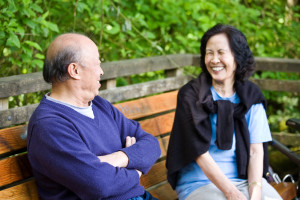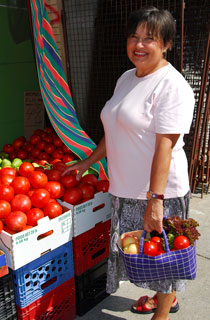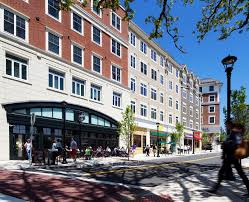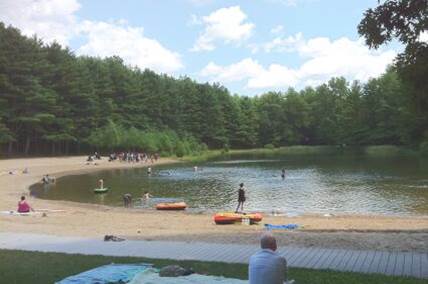Community Engagement

All Connecticut communities strive to be vibrant, intergenerational places with opportunities for community engagement across the lifespan. Community engagement includes support and connectivity, civic engagement, and opportunities for both employment and recreation.
- Communities in which individuals of all ages are valued and work together enhance the quality of life for all.
- Older adults enhance community capacity by contributing their experience and leadership to support community establishments, engaging in continuing education, addressing critical community issues as paid and unpaid workers, and acting as local economic participants.
- Community engagement serves a protective role in maintaining and even promoting the health, well-being and cognitive ability of older adults.
- Conversely, studies have repeatedly linked social isolation to poor health outcomes, including increased risk for shortened life expectancy, dementia, rehospitalization and increased numbers of falls.
Recommendations for Communities
_____ Promote public awareness about existing community engagement opportunities.
_____ Cultivate an atmosphere that promotes diversity and inclusiveness.
_____ Mobilize older adults to address community issues through meaningful paid and unpaid opportunities, especially to address workforce shortages, to support community institutions and to serve on municipal boards and commissions.
_____ Promote opportunities for intergenerational contribution. For example, young parents need child care, while older adults need transportation for errands; teenagers need employment while older adults need help with small chores around the house.
_____ Support settings for intergenerational learning through adult and continuing education, including job retraining programs for older adults.
_____ Facilitate opportunities for religious, spiritual and social connectivity.
_____ Facilitate opportunities for local economic development.
Resources
- The Intergenerational Center at Temple University: Connecting generations to strengthen communities
- Generations United
- Civic Engagement and Recent Immigrant Communities: A planning guide for local officials and other community leaders (with broader applications beyond immigrant communities)
- The Role of Local Elected Officials in Economic Development
- Encore: Second Acts for the Greater Good
- Older Adults as Engaged Volunteers
Health Services

Livable communities are ones that promote the health and well-being of all Connecticut residents, including older adults. And it’s about more than just access to high quality, affordable health care—it’s about creating the conditions in which people can be healthy.
- With a primary focus on wellness and prevention, local public health efforts work to prevent disease, injury and disability, and promote conditions that support good health. In other words, public health efforts ideally prevent the need for health care interventions to begin with.
- At least half of all health outcomes may be driven by community conditions—such as access to quality, affordable housing in walkable neighborhoods, broad transportation options, and community safety. Community conditions can impact physical activity levels, food access, air quality, social cohesion, and economic opportunities. All have profound implications for health.
- Planning for potential disasters benefits everyone but is particularly critical to people with access or functional needs, who may be challenged during or after an emergency.
- Creating healthier communities requires strategic collaborations across a broad range of sectors.
Recommendations for Communities
_____ Support a robust local public health system to:
- Promote in-home programs that improve health outcomes;
- Provide wellness programs and preventive health services, such as screenings and immunizations;
- Provide health education on various health topics;
- Ensure food and environmental safety; and
- Conduct disease surveillance, report analysis, case investigation and coordination to reduce disease transmission
_____ Support local health departments, senior centers and other partners in their efforts to prevent falls through various strategies, including home safety assessments, fall prevention seminars and exercise classes, medication safety reviews and training for service providers.
_____ Formalize partnerships between health care, public health and social services leaders and professionals to ensure an integrated system that comprehensively meets the needs of older adults, which can include addressing social isolation, loss and mental health issues.
_____ Formalize partnerships with town planners to maximize opportunities for Smart Growth to promote more active lifestyles.
_____ Collaborate with local, state and regional transit leadership to create a balanced transportation system that connects residents with quality health care services.
_____ Ensure capacity and capability to plan for, respond to and recover from public health emergencies for all community residents, including those with access and functional needs.
_____ Conduct health impact assessments to determine the potential health implications of projects, policies and community design on residents.
_____ Prioritize access to healthy and affordable foods and safe opportunities for physical activity for all residents.
Resources
- Connecticut State Health Assessment and Improvement Plan
- Healthy Connecticut 2020 Performance Dashboard
- Healthy Planning Guide
- A Sustainability Planning Guide for Healthy Communities
- Housing and Health: New Opportunities for Dialogue and Action
- Understanding the Role of Community Development Finance in Improving Access to Healthy Food: A Guide for Public Health Practitioners
- Bicycling and Walking in the United States: 2014 Benchmarking Report
- National Prevention Strategy: America’s Plan for Better Health and Wellness
- Healthy People 2020 Topic Area, Older Adults
- The HIA [Health Impact Assessment] Process
Housing
Older adults generally want to age in place, in familiar home and neighborhood environments. Accordingly, a broad range of accessible, affordable and creative housing options is a critical component of a livable community.
- To remain accessible, homes may need to be inspected for safety hazards (e.g., poor lighting, inappropriately placed carpets and other floor items) and may need to be physically modified (e.g., zero-step entry, wider doorways, and bathroom aids) to accommodate emerging impairments.
- Communities need to invest in growing their stock of affordable housing. Age-diverse communities and development, rather than age-segregated solutions, are necessary to enhance quality of life for all, from Millennials to older adults to the professionals needed to support older people.
- Co-housing arrangements, including shared housing and accessory dwelling units, can enhance Connecticut’s plentiful single-family housing stock to promote aging in place and increase housing affordability.
Recommendations for communities
____ Educate residents on what sorts of home remodeling or modifications may be necessary to successfully support aging in place.
____ Through regional cooperation, compile a listing of vetted home repair and home modification contractors and programs to help older adults and persons with disabilities adapt their homes to meet their changing needs.
____ Adopt policies that encourage incorporation of accessible housing features into new construction, so that new housing can support its residents throughout the lifespan.
____ Ensure that adequate smaller, energy-efficient, affordable housing—in walkable, transit-served, mixed use neighborhoods—exists in every community for all residents, including older adults and persons with disabilities who want or need to change their housing to accommodate their evolving needs.
____ Collaborate with affordable and low-income housing developers to generate these additional housing options so that residents may remain in their community.
____ Consider tax code or tax payment system changes to accommodate those living on fixed incomes, who may struggle to pay rising rents or property taxes.
____ Modify zoning codes and plans of conservation and development to support co-housing arrangements, including shared housing and accessory dwelling units.
Resources
- Connecticut Fair Housing Center’s People, Place and Opportunity: Mapping Communities of Opportunity in Connecticut
- 2015 Connecticut Housing Data Profiles (Partnership for Strong Communities)
- Partnership for Strong Communities’ Housing in CT 2014
- Housing America’s Older Adults: Meeting the Needs of an Aging Population
- Increase the Availability of Affordable Homes Toolkit
- Meet the Housing Needs of Older Adults Toolkits
- Accessory Apartments (Fact sheet)
- Shared Housing (Fact sheet)
- Cohousing Association of the United States: What is Cohousing?
- Fair Housing Accessibility FIRST
- Home Fit Guide
- National Resource Center on Supportive Housing and Home Modification: Guide to Home Modification
- National Association of Homebuilders Aging-in-Place Specialist Certification
Planning and Zoning

Planning and zoning have far-reaching implications for community life, dictating, for example, how well residential areas are connected to businesses, medical services, and community and civic centers.
- Historically, planning and zoning separated commercial and residential land uses. This practice, promoting car-dependent sprawl, was adopted at a time when older adults constituted a smaller demographic of the population and life expectancies were shorter. The result today is a significant number of older adults who are aging in suburbia.
- Increasingly, communities are embracing Smart Growth, a set of planning principles that promote more compact, walkable, mixed-use, mixed-income, environmentally sensitive communities with a range of transportation and housing choices.
- Demand is coming not only from older adults, but from individuals across the lifespan.
- While Smart Growth benefits everyone in a community, good community design is a fundamental necessity to successfully age in place. It can promote social cohesion and physical activity and connectivity to available public transit and essential services.
- Zoning can be used to promote housing arrangements that support
residents across the lifespan by- Including accessory dwelling units and shared housing;
- Reducing minimum lot sizes to allow for higher-density development; and
- Encouraging universal design features in new construction.
Recommendations for Communities
_____ Ensure that municipal plans of conservation and development include planning for older adults and individuals with disabilities to remain in their homes and communities, pursuant to Public Act 13-250.
_____ Revise zoning codes to promote safe, intergenerational communities by maximizing opportunities for Smart Growth. Smart Growth includes:
- Mixing land uses;
- Taking advantage of compact building design;
- Creating a range of housing opportunities and choices;
- Creating walkable neighborhoods;
- Fostering distinctive, attractive communities with a strong sense of place;
- Preserving critical environmental areas;
- Strengthening and directing development towards existing communities;
- Providing a variety of transportation choices;
- Making development decisions predictable, fair, and cost effective; and
- Encouraging stakeholder collaboration in development decisions
_____ Create diverse, accessible and affordable housing and transportation choices by
- Promoting housing arrangements to support residents across the lifespan, including accessory dwelling units and shared housing;
- Reducing minimum lot sizes to allow for higher-density development;
- Encouraging universal design features in new construction;
- Adopting policies that support complete streets, transit-oriented development, and robust fixed-route and demand responsive transportation systems; and
- Conduct health, environmental, and economic impact assessments to ensure that land use planning projects and policies take into consideration the potential implications of community design on all residents.
Resources
- Fiscal Implications of Development Patterns
- Conservation and Development Policies: The Plan for Connecticut (2013-2018)
- Connecticut Zoning Initiative
- Sustainable Land Use Code Project. Model Regulations
- Capitol Regional Green Clearinghouse
- Promote Sustainable and Equitable Development Toolkit
- Halfway There: How to Create Land Use Policy That Makes the Most of Connecticut’s Transit Network
- Multigenerational Planning: Using smart growth and universal design to link the needs of children and the aging population
- American Planning Association Smart Growth Policy Guide
- American Planning Association Aging in Community Policy Guide
- The Smart Growth Network
- Change Lab Solutions’ Pedestrian Friendly Code Directory
- Health Impact Assessment Fact Sheet
Public Spaces and Buildings

Livable communities have safe and accessible public spaces and buildings—ranging from green spaces to places of civic engagement to places for commerce—that help foster a sense of community and mutual caring. They are designed and built to provide a foundation for true neighborhoods and opportunities for intergenerational connectivity. And they accommodate users of all ages and abilities.
Recommendations for Communities
_____ Increase access to parks, school playgrounds and other recreational facilities in underserved neighborhoods.
_____ Establish community gardens in strategic locations.
_____ Ensure that public buildings and spaces are accessible for all users and designed and located to enhance community safety and promote opportunities for intergenerational interactions.
_____ Rehabilitate blighted, vacant and otherwise underutilized properties.
_____ Encourage diverse use of public spaces and buildings.
Resources
- Placemaking for an Aging Population: Guidelines for Senior-Friendly Parks
- Streets as Places: Using Streets to Rebuild Communities
- Model Joint Use Resolution
- This Land is Our Land: A Primer on Public Land Ownership and Opportunities for Recreational Access
- Building in Healthy Infill: A Guide for Improving Public Health Through Development
- Dig, Eat and Be Healthy: A Guide to Growing Food on Public Property
- The ADA and City Governments: Common Problems
- Americans with Disabilities Act: ADA Guide for Small Towns
- ADA Update: A Primer for Small Business
Social Services

Livable communities have adaptable social services to support aging in place. Social and support services are broad and can relate to mobility, nutrition, personal care, financial management and other areas.
- Minor changes in physical or mental condition can sometimes spur radical life changes, such as a move into an institutional setting because adequate services are not available, accessible or not known.
- Connecticut’s Commission on Women, Children and Seniors has engaged in collaborative, long-standing work to choose how and where people receive long-term services and supports. From this work, we know that people want to be able to stay in their communities and have choice, independence and dignity.
- Robust social services and supports can prevent initial and repeated encounters with the health care system, improve quality of life, and keep people in their homes and communities.
- Social services and supports help people carry out a range of activities, such as
- The tasks necessary for independent community living, such as shopping, meal preparation, managing finances, and house cleaning and maintenance;
- The tasks necessary to maintain an active and engaged life, such as work and recreation; and
- In some cases, basic functions such as eating, dressing or bathing.
- Effective community-level primary mental health care for older adults is not only critical in and of itself but also promotes the overall health of older adults, prevents disease and helps manage chronic illness.
- Religious, spiritual and social connectivity can be vital to ensuring the physical and emotional well-being of older adults.
- Caregivers, providing supports to spouses, parents, children, other relatives or friends, also require support in their important and economically valuable role.
- Naturally occurring retirement communities (NORCs) are an example of an innovative social and support delivery model. They leverage the geographic clustering of older adults to deliver targeted social and supportive services to help residents age in place.
Recommendations for Communities
_____ Support a robust local social services system that addresses community needs through strategic collaborations among and between other municipal departments and divisions—like parks and recreation, public health and transportation services—and community leaders. Explore opportunities for regional collaboration.
_____ Promote public awareness of and information about existing social and support services available.
_____ Promote opportunities for mutual intergenerational support. For example, young parents need child care, while older adults need transportation for errands; teenagers need employment while older adults need help with small chores around the house.
_____ Promote information, training and support for family caregivers across the lifespan, including grandparents raising grandchildren.
education and prevention of physical and financial elder abuse and exploitation.
_____ Promote and support collaboration among police, fire, aging services and adult protective services for safety education and prevention of physical and financial elder abuse.
Resources
- County Health Rankings & Roadmaps: Integrate social services
- Naturally Occurring Retirement Community Aging in Place Initiative
- Village to Village Network
- Helping Caregiving Families
Transportation
Transportation is the vital link that connects residents with their communities and the elements of a vibrant and engaged life. Although Connecticut has a strong presence of car-dependent land use patterns, our state also has strong town centers that can be built upon to create a broader array of transportation options. Benefits of broadening transportation options include:

- Healthier, more active lifestyles for everyone;
- Lowered vehicular congestion and air pollution because of reduced driving;
- Improved connectivity between residents and economic opportunities; and
- Reduced household transportation costs, freeing up income for other purposes.
Creating diverse, accessible and affordable transportation choices benefits everyone, but is especially critical for the third of the population that does not drive, including older adults, children, individuals with disabilities, and those who do not own a vehicle.
Fixed Route and Demand-Responsive Transportation Systems
A fixed route transportation system is one that operates along a prescribed route and on a fixed schedule. Such systems can include buses, subways, and light rail systems. Demand-responsive systems have timing and routes more individually tailored to the needs of the user and can include para-transit, shared transit or dial-a-ride services, as well as vans, other shuttle bus systems and taxis.
- Demand for these transportation systems and services is expected to increase as Connecticut’s population continues to age.
- Transit vehicles must be comfortable and accessible to the populations served.
- Fiscal constraints require a need to creatively identify funding sources to sustain and grow these systems.
- Regional transportation coordination across towns and across provider types is critical to ensuring that people get where they need to go efficiently.
Complete Streets are designed and operated to safely accommodate all users, including pedestrians, bicyclists, motorists and transit-riders of all ages and abilities.

- There is no singular Complete Streets design principle, with urban, suburban and rural communities encouraged to adopt different plans to suit their unique community contexts.
- Complete Street elements may include sidewalks, bicycle lanes or wide paved shoulders, dedicated bus lanes, comfortable and accessible public transportation stops, frequent and safe crossing opportunities, median islands, curb extensions, curb cuts, narrower motorist travel lanes, and roundabouts, among other possible elements.
- Universally, Complete Streets promote safety and convenience for everyone using the road, ensuring that residents can access all available transportation options.
Recommendations for Communities
_____ Promote public awareness of and information about existing transportation services.
_____ Develop or enhance mobility management programs to help older adults and other community members learn how to access and navigate transportation options.
_____ Engage in transit-oriented development to ensure that compact, walkable, mixed-use, mixed-income communities are located within a half-mile of quality, dependable public transportation.
_____ Identify funding streams to sustain and grow both fixed route and demand-responsive transportation options.
_____ Conduct a walkability audit to assess sidewalks, crosswalks, and pedestrian linkages to essential services.
_____ Adopt and implement complete streets to accommodate all users, regardless of age or ability.
Resources
- NACTO Urban Street Design Guide
- Evaluating Complete Streets Projects: A Guide for Practitioners
- TransformCT: What’s Your Vision for Transportation in Connecticut?
- Connecticut Department of Transportation Complete Streets Policy Statement
- Connecticut 2014 Bike-friendly, Walk-friendly Town Scorecard
- Connecticut Bicycle and Pedestrian Advisory Board Annual Report (2013)
- Complete Streets in a Box Toolkit: Connecticut
- National Complete Streets Coalition
- Change Lab Solutions: Model Laws and Resolutions for Complete Streets
- Change Lab Solutions’ Pedestrian Friendly Code Directory
- City of New Haven Complete Streets Design Manual
- Dangerous by Design: 2014
- Smart Mobility for a 21st Century America
- Building Equity: Race, Ethnicity, Class and Protected Bike Lanes
- Improving Public Transit Options for Older Persons
- Aging in Place, Stuck without Options: Fixing the Mobility Crisis Threatening the Baby Boom Generation

